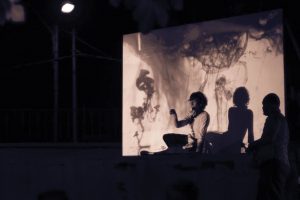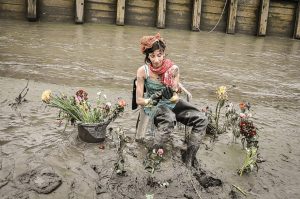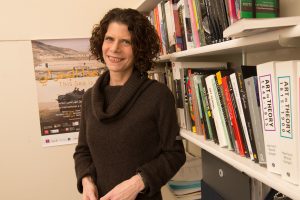Any type of credible research requires good sources. When the crux of your academic work involves Israel and Palestine, and the West Bank in particular, the challenges come quickly and can seem insurmountable. This is a famously complicated part of the world, never mind the fact that the researcher in question, Elisabeth Friedman, an associate professor of art history and visual culture at Illinois State University, has no political axe to grind. Eventually, politics permeates everything here, including—and sometimes, especially—art and artists.
Friedman’s research examines Palestinian art and artists through the prism of the 2016 Qalandiya International Art Biennial (QI), a visual cultural exhibit that promotes Palestinian art and takes place every two years across Palestine, and for that year, internationally, in Beirut, Lebanon; Amman, Jordan; and London, England.
The QI is significant, Friedman said, because it is the only biennial art exhibition that takes place under a military occupation. “I’m interested in the implications of that in how QI is conceived and planned. What are the challenges? How must such a biennial be structured?”
Appears In
Uncovering the past: ISU students dig into history of 800-year-old village
Chemistry students find true mentor in research laboratory
Hidden pain: ISU scholar interviews mothers of sexual assault victims
Unraveling the tapestry of religion and politics: Distinguished Professor Ali Riaz sheds lights on rise of extremism
ISU researchers land grant to acquire high-tech biology tool
Ask a Redbird Scholar: Are there health benefits to eating meat?
Ask a Redbird Scholar: Could the U.S. ever have a fascist leader?
Redbird media: Latest books from ISU faculty and staff
Ask a Redbird Scholar: Why are humans bent on self-destruction?
Research spotlight: Center for the Study of Education Policy
Ask a Redbird Scholar: Do our voices age?
Q&A with Aysen Bakir: A look into the billion dollar business of children’s advertising
For Friedman, just getting into Palestine to meet with her sources has been her greatest challenge. “Israel controls who gets in and out,” she said. “I have to be careful what I say at the border.”
Friedman has been delayed for several hours while authorities determined whether she was a threat or was sympathetic to Palestinians. During one long and unsettling delay, she recalled wanting to scream, “I just want to do my research!”
Work such as hers, even though it is about art, is officially and legally deemed by Israel as political activity, said Friedman, who has been at Illinois State since 2008. She started traveling to the region in 2013 and has gone every year since.
“I meet with people on the ground, under occupation,” she said. “Most settler-colonial situations are in the past, but (Israeli occupation) goes on and on, and it’s U.S.-sanctioned. There are still people living in refugee camps.”
Her research method is designed to view firsthand what goes into preparing for the QI. By speaking with artists, curators, administrators, and local residents, she investigates how participants are able to conduct an international art exhibition while enduring a military occupation.
Friedman focuses on the institutional level, the curatorial level, and on four artists with whom she spent time during her last visit. She is interested in trends in art, including participatory and public engagement art. She has a specific and intense interest in quiet protest art.
“It has to be subtle, subversive, so the artist doesn’t get arrested,” Friedman said.
Participating emerging artists Mirna Bamieh, from Ramallah, and Riham Isaac, from Bethlehem, continue to pursue their art despite obstacles. Bamieh’s public performance piece, the intimate Potato Talks, invites strangers to sit closely across from each other on a busy city street and tell their personal stories while peeling potatoes. Isaac’s multimedia live performance, I Am You, uses music, dance, video, and poetry to show the links between disparate people.
Midcareer artist Benji Boyadgian, from Tantour, uses his paintings in The Temporary Ruin to document the disappearing Palestinian landscape resulting from Jerusalem’s “illegal settlement expansion.” And, early career artist Mona Marouf from Jerusalem uses special-effects makeup to “subversively perform issues relating to Palestinian society” and to Jerusalemites.
The QI itself, in some sense, is the ultimate example of protest art as it protests boundaries that have been forced upon Palestinians. Friedman’s research asks a big question: Can art serve as a form of resistance to the occupation?
Friedman’s research includes interviews of participants, visual analysis, and archival research. She has also traced the institutional and artistic progression of the biennial. She has been on hand to observe the organizational preparations that lead up to a biennial and has attended a QI in its entirety.
A National Endowment for Humanities (NEH) Palestinian American Research Center (PARC) Fellowship has supported Friedman’s research and travel. The fellowship gave her the means to move to an apartment in Ramallah for eight months of research. She was there from September 2016 through April 2017, by far the longest of her six trips.
“My understanding of Palestine in general, and of Palestinian art, culture, and their politics in particular, has deepened immeasurably during this period.”

Her interest in art produced in Palestine came unexpectedly when, during one of her trips, she traveled to the West Bank for the first time.
“I was surprised by the vibrant art coming out of the West Bank,” she said. “There is an organized Zionist lobby that seeks to suppress all discussion of the occupation, including academic research and art exhibits in the U.S.”
Zionist lobbies, in this context, Friedman said, are groups funded and organized by the state of Israel to protest professors who critique Israel or write about the occupation. And Israel restricts which Palestinians can cross borders. This applies to everyone, including artists and even their art, which also cannot travel freely.
“The pettiness of it and the humiliation of Palestinians was very much a shock for me,” said Friedman, who is Jewish.
Her research has already seen her produce journal articles, a book chapter, an essay, and a number of lectures and conference presentations. She is currently working on additional journal articles and a book, The Qalandiya International Biennial and the New Geographies of Palestinian Art.
Some of her findings include learning “how precarious and haphazard the planning and organization of the QI is,” with no central curator, for example. Another finding from her research has been that artists are more forthcoming about their work than administrators at institutions are willing to be.
In describing her research for her PARC Fellowship, she noted that the QI began as “a model in institutional cooperation: a way to cross borders, to bring Palestinians together to resist the occupation.” In the six years since the QI began, however, the strain of the occupation has seen those ideals erode over time, she wrote. She also surmised that while the institutions have struggled in their development, artists remain determined to succeed in creating provocative art even without that supporting infrastructure in the form of museums and academies.
“The occupation will not succeed in erasing Palestinian art and culture no matter how dire the institutional situation may become,” Friedman said.
An additional and crucial element of her success in pursuing her research has been the support of her department, notably her chair in the School of Art. “Mike Wille has been amazing,” she said.

Back home on campus, she teaches a course—Visual Culture in Palestine and Israel—that combines history and art history. Her co-teacher for the class is Issam Nassar, a professor in Illinois State’s Department of History. Nassar is Palestinian and from the area around Ramallah.
“He took me on my first trip in 2013 to Ramallah,” Friedman said. “He made it a point to help me make contacts there in the art world.”
Nassar’s kindness and support—unbound by borders or bitterness—have been invaluable to her, she said.
The next biennial is scheduled for October 2018. Her goal is to make another trip at that time to continue her work.
John Moody can be reached at jemoody2@IllinoisState.edu.



